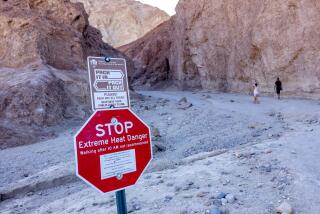Bigger wildfires. Worsening droughts. More disease. How climate change is battering California
- Share via
Bigger, more dangerous wildfires. Coastlines threatened by rising sea levels. Less water. More heat-related illnesses.
These are some of the ways climate change is rapidly changing California and the West, with conditions only expected to worsen, according to a landmark federal report, the first of its kind under the Trump administration.
Here are some key excerpts from the report about how global warming is already changing California:
Wildfires
Analyses estimated that the area burned by wildfire across the western United States from 1984 to 2015 was twice what would have burned had climate change not occurred. Wildfires around Los Angeles from 1990 to 2009 caused $3.1 billion in damages (unadjusted for inflation). Tree death in mid-elevation conifer forests doubled from 1955 to 2007 due, in part, to climate change. Allowing naturally ignited fires to burn in wilderness areas and preemptively setting low-severity prescribed burns in areas of unnatural fuel accumulations can reduce the risk of high-severity fires under climate change. Reducing greenhouse gas emissions globally can also reduce ecological vulnerabilities.
Sea level rise
At the Golden Gate Bridge in San Francisco, sea level rose 9 inches between 1854 and 2016. Climate change caused most of this rise by melting of land ice and thermal expansion of ocean water. Local governments on the California coast are using projections of sea level rise to develop plans to reduce future risks. Ocean water acidity off the coast of California increased 25% to 40% from the preindustrial era (circa 1750) to 2014 due to increasing concentrations of atmospheric carbon dioxide from human activities. The marine heat wave along the Pacific Coast from 2014 to 2016 occurred due to a combination of natural factors and climate change. The event led to the mass stranding of sick and starving birds and sea lions, and shifts of red crabs and tuna into the region. The ecosystem disruptions contributed to closures of commercially important fisheries.
Drought
Water for people and nature in the Southwest region has declined during droughts, due, in part, to human-caused climate change. Higher temperatures intensified the recent severe drought in California and are amplifying drought in the Colorado River Basin. Since 2000, Lake Mead on the Colorado River has fallen 130 feet and lost 60% of its volume, a result of the ongoing Colorado River Basin drought and continued water withdrawals by cities and agriculture. The reduction of water volume in both Lake Powell and Lake Mead increases the risk of water shortages across much of the Southwest.
Local water utilities, the governments of seven U.S. states, and the federal governments of the United States and Mexico have voluntarily developed and implemented solutions to minimize the possibility of water shortages for cities, farms and ecosystems. In response to the recent California drought, the state implemented a water conservation plan in 2014 that set allocations for water utilities and major users and banned wasteful practices. As a result, the people of the state reduced water use 25% from 2014 to 2017.
Drought and increasing heat intensify the arid conditions of reservations where the United States restricted some tribal nations in the Southwest region to the driest portions of their traditional homelands. In response to climate change, indigenous peoples in the region are developing new adaptation and mitigation actions.
The severe drought in California, intensified by climate change, reduced hydroelectric generation two-thirds from 2011 to 2015. Hantavirus pulmonary syndrome, and Valley fever cases occur in the region.
Heat
Exposure to hotter temperatures and heat waves already leads to heat-associated deaths in Arizona and California. Mortality risk during a heat wave is amplified on days with high levels of ground-level ozone or particulate air pollution. Given the population in the Southwest region, it experiences a disproportionate number of West Nile virus and plague cases. Increasing heat stress during specific phases of the plant life cycle can increase crop failures.
More to Read
Sign up for Essential California
The most important California stories and recommendations in your inbox every morning.
You may occasionally receive promotional content from the Los Angeles Times.










